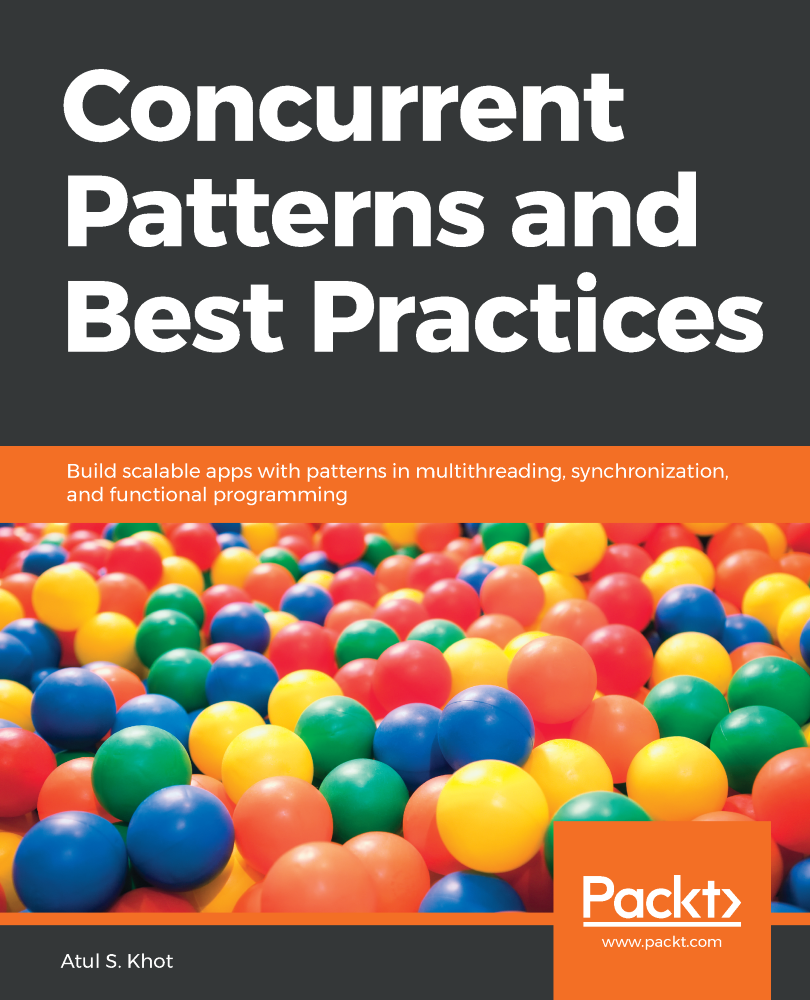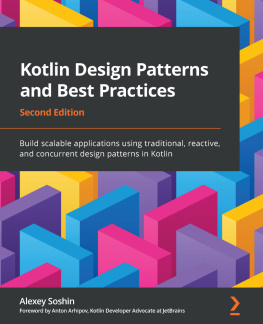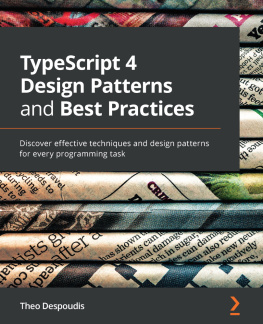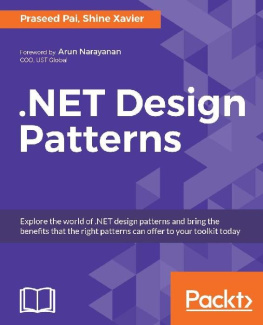
Concurrent Patterns and Best Practices
Build scalable apps with patterns in multithreading, synchronization, and functional programming
Atul S. Khot

BIRMINGHAM - MUMBAI
Concurrent Patterns and Best Practices
Copyright 2018 Packt Publishing
All rights reserved. No part of this book may be reproduced, stored in a retrieval system, or transmitted in any form or by any means, without the prior written permission of the publisher, except in the case of brief quotations embedded in critical articles or reviews.
Every effort has been made in the preparation of this book to ensure the accuracy of the information presented. However, the information contained in this book is sold without warranty, either express or implied. Neither the authors, nor Packt Publishing or its dealers and distributors, will be held liable for any damages caused or alleged to have been caused directly or indirectly by this book.
Packt Publishing has endeavored to provide trademark information about all of the companies and products mentioned in this book by the appropriate use of capitals. However, Packt Publishing cannot guarantee the accuracy of this information.
Commissioning Editor: Richa Tripathi
Acquisition Editor: Denim Pinto
Content Development Editor: Nikhil Borkar
Technical Editor: Divya Vadhyar
Copy Editor: Muktikant Garimella
Project Coordinator: Ulhas Kambali
Proofreader: Safis Editing
Indexer: Rekha Nair
Graphics: Disha Haria
Production Coordinator: Nilesh Mohite
First published: September 2018
Production reference: 1260918
Published by Packt Publishing Ltd.
Livery Place
35 Livery Street
Birmingham
B3 2PB, UK.
ISBN 978-1-78862-790-0
www.packtpub.com
mapt.io
Mapt is an online digital library that gives you full access to over 5,000 books and videos, as well as industry leading tools to help you plan your personal development and advance your career. For more information, please visit our website.
Why subscribe?
Spend less time learning and more time coding with practical eBooks and Videos from over 4,000 industry professionals
Improve your learning with Skill Plans built especially for you
Get a free eBook or video every month
Mapt is fully searchable
Copy and paste, print, and bookmark content
packt.com
Did you know that Packt offers eBook versions of every book published, with PDF and ePub files available? You can upgrade to the eBook version at www.packt.com and as a print book customer, you are entitled to a discount on the eBook copy. Get in touch with us at customercare@packtpub.com for more details.
At www.PacktPub.com , you can also read a collection of free technical articles, sign up for a range of free newsletters, and receive exclusive discounts and offers on Packt books and eBooks.
Contributors
About the authors
Atul S. Khot is a self-taught programmer and has written software programmes in C and C++. Having extensively programmed in Java and dabbled in multiple languages, these days, he is increasingly getting hooked on Scala, Clojure, and Erlang. Atul is a frequent speaker at software conferences and a past Dr. Dobb's product award judge. He was the author of Scala Functional Programming Patterns and Learning Functional Data Structures and Algorithms, published by Packt Publishing.
About the reviewer
Anubhava Srivastava is a Lead Engineer Architect with more than 22 years of systems engineering and IT architecture experience. He has authored the book Java 9 Regular Expressions published by Packt Publishing. He's an active contributor to Stackoverflow and figures in its top 0.5% overall reputation. As an open source evangelist he actively contributes to various open source development and some popular computer programming Q&A sites like Stack Overflow with a reputation/score of more than 170k.
Packt is searching for authors like you
If you're interested in becoming an author for Packt, please visit authors.packtpub.com and apply today. We have worked with thousands of developers and tech professionals, just like you, to help them share their insight with the global tech community. You can make a general application, apply for a specific hot topic that we are recruiting an author for, or submit your own idea.
Preface
Thank you for purchasing this book! We live in a concurrent world and concurrent programming is an increasingly valuable skill.
I still remember the Aha! moment when I understood how UNIX shell pipeline works. I fell headlong in love with Linux and the command line and tried out many combination filters (a filter is a program reading from standard input and writes to standard output) connected via pipes. I was amazed by the creativity and power brought about by the command line. I was working with concurrent programs.
Then, there was a change of project and I was thrown headlong into writing code using the multithreaded paradigm. The language was C or C++, which I loved deeply; however, to my surprise I found that it was a herculean effort to maintain a legacy code base, written in C/C++ that was multithreaded. The shared state was managed in a haphazard way and a small mistake could throw us into a debugging nightmare!
Around that time, I came to know about object oriented (OO) design patterns and some multithreaded patterns as well. For example, we wanted to expose a big in-memory data structure safely to many threads. I had read about the Readers/Writer lock pattern, which used smart pointers (a C++ idiom) and coded a solution based on it.
Voila! It just worked. The concurrency bugs simply disappeared! Furthermore, the pattern made it very easy to reason about threads. In our case, a writer thread needed infrequent but exclusive access to the shared data structure. The reader threads just used the structure as an immutable entityand look mom, no locks!
No locks! Well, well, well... this was something new! As the locks disappeared, so did any possibility of deadlocks, races, and starvation! It felt just great!
There was a lesson I learned here! Keep learning about design patterns and try to think about the design problem at hand - in terms of patterns. This also helped me reason better about the code! Finally, I had an inkling of how to tame the concurrency beast!
Design patterns are reusable design solutions for common design problems. The design solutions are design patterns. Your problem domain may vary, that is, the business logic you need to write will be applicable to solving the business problem at hand. However, once you apply the pattern, things just fall in place, more or less!
For example, when we code using the OO paradigm, we use the Gang Of Four (GOF)
Next page









